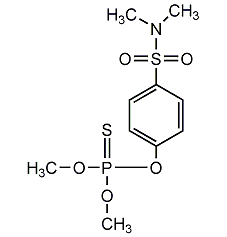
Structural formula
| Business number | 015N |
|---|---|
| Molecular formula | C10H16NO5PS2 |
| Molecular weight | 325.34 |
| label |
amphosphonate, O-{4-[(Dimethylamino)sulfonyl]phenyl}-O,O-dimethylphosphorothioate, Famfur, Famphos, Famophos, Warbex, O-{4-[(Dimethylamino)sulfonyl]phenyl}-O,O-dimethyl phosphorothioate, Organophosphorus pesticides |
Numbering system
CAS number:52-85-7
MDL number:MFCD00055307
EINECS number:200-154-0
RTECS number:TF7650000
BRN number:2224254
PubChem ID:None
Physical property data
1. Characteristics: Colorless crystal
2. Density ( g/mL,25/4℃): Undetermined
3. Relative steam Density (g/mL,AIR=1): Undetermined
4. Melting point ( ºC):55
5. Boiling point ( ºC,Normal pressure): Undetermined
6. Boiling point ( ºC, 13.33kpa):
7. Refractive Index : Undetermined
8. Flashpoint (ºC): Undetermined
9. Specific optical activity Degree (º,): Undetermined
10. Spontaneous ignition point or ignition temperature (ºC): Undetermined
11. Vapor Pressure (kPa,25ºC): Undetermined
12. %,V/V): Undetermined
18. Lower explosion limit (%,V/V): Undetermined
19. Solubility :Solubility in water is100mg/L. Soluble in xylene, chloroform, acetone and other solvents.
Toxicological data
1, acute toxicity: rat oral LD50: 28mg/kg; Rat, skin contact LD50: 400mg/kg; Small Mouse oral LD50: 9500ug/kg; Mouse abdominal cavity LD50: 11600ug/kg;
Rabbit, skin contact LD50: 1460 mg/kg; wild bird oral LD50:180ug/kg
2, other multi-dose toxicity: rat oral TDLo: 13500ug/kg/90D- C
Ecological data
None
Molecular structure data
1. Molar refractive index: 76.92
2. Molar volume (m3/mol):240.2
3. isotonic ratio(90.2K):641.9
4. Surface Tension(dyne/cm):50.9
5. Polarizability(10-24cm3):30.49
Compute chemical data
1. Reference value for hydrophobic parameter calculation (XlogP): None
2. Number of hydrogen bond donors: 0
3. Number of hydrogen bond acceptors: 7
4. Number of rotatable chemical bonds: 6
5. Number of tautomers: none
6. Topological molecule polar surface area 106
7. Number of heavy atoms: 19
8. Surface charge: 0
9. Complexity: 418
10. Number of isotope atoms: 0
11. Determine the number of atomic stereocenters: 0
12. Uncertain number of atomic stereocenters: 0
13. Determine the number of chemical bond stereocenters: 0
14. Number of uncertain chemical bond stereocenters: 0
15. Number of covalent bond units: 1
Properties and stability
None
Storage method
None
Synthesis method
Dimethoxyphosphorothioate chloride can be reacted with p-dimethylaminosulfonylphenol Preparation.
Purpose
Used to prevent and control internal and external parasites in livestock, such as body lice, wild fly larvae, subcutaneous fly larvae, etc. Preparations include powder and pouring agent.
; TEXT-ALIGN: left; mso-list: l0 level2 lfo1; tab-stops: list 36.0pt; mso-margin-top-alt: auto; mso-margin-bottom-alt: auto” align=left>2. Molar volume (m 3/mol):240.2
3. isotonic ratio(90.2K):641.9
4. Surface Tension(dyne/cm):50.9
5. Polarizability(10-24cm3):30.49
Compute chemical data
1. Reference value for hydrophobic parameter calculation (XlogP): None
2. Number of hydrogen bond donors: 0
3. Number of hydrogen bond acceptors: 7
4. Number of rotatable chemical bonds: 6
5. Number of tautomers: none
6. Topological molecule polar surface area 106
7. Number of heavy atoms: 19
8. Surface charge: 0
9. Complexity: 418
10. Number of isotope atoms: 0
11. Determine the number of atomic stereocenters: 0
12. Uncertain number of atomic stereocenters: 0
13. Determine the number of chemical bond stereocenters: 0
14. Number of uncertain chemical bond stereocenters: 0
15. Number of covalent bond units: 1
Properties and stability
None
Storage method
None
Synthesis method
Dimethoxyphosphorothioate chloride can be reacted with p-dimethylaminosulfonylphenol Preparation.
Purpose
Used to prevent and control internal and external parasites in livestock, such as body lice, wild fly larvae, subcutaneous fly larvae, etc. Preparations include powder and pouring agent.
�etc. Preparations include powder and pouring agent.

 微信扫一扫打赏
微信扫一扫打赏

